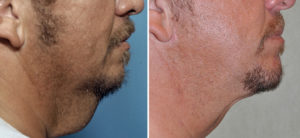There are many bodily changes that take place when one loses a lot of weight and they are well recognized as general skin and soft tissue sag. But the face is not immune to weight loss changes. It creates equal issues of volume loss and sag resulting in a droopy deflated face and obvious turkey neck deformities. In young patients this effect makes them look older and saggy while in older patients it just makes them look even older even though they have dramatically improved a significant medical problem. (their weight)
The treatment of the weight loss face and neck is largely a lower facelift. This is the only way to redrape the loose skin over the neck and jawline. But the weight loss patient also suffers from volume deflation in such areas as the cheeks and temples. This makes weight loss facelifts unique and with slightly different considerations than many of the typical facial aging patients.
In the February 2015 issue of the journal Plastic and Reconstructive Surgery, a paper was published entitled ‘Face Lifting in the Massive Weight Loss Patient: Modifications of Our Technique for This Population’. Twenty two weight loss facelift patients (15 women, 7 men) were retrospectively reviewed. The average of the patients were around 52 years old with average body mass indexes of 26. Most (near 90%) had noticeable volume loss in the midface and nasolabial folds, 60% has perioral volume loss and over 80% had platysmal bands. For their facelift techniques, 90% had some form of SMASectomy and all patients received fat grafting. The average amount of fat grafting was over 20mls.

Dr. Barry Eppley
Indianapolis, Indiana


